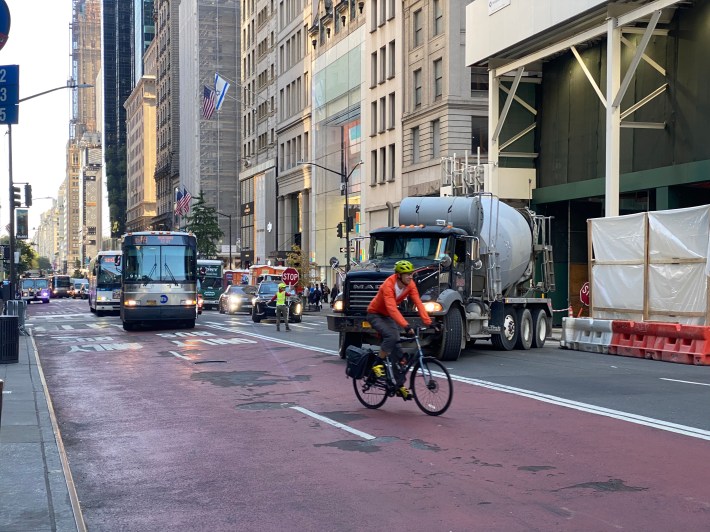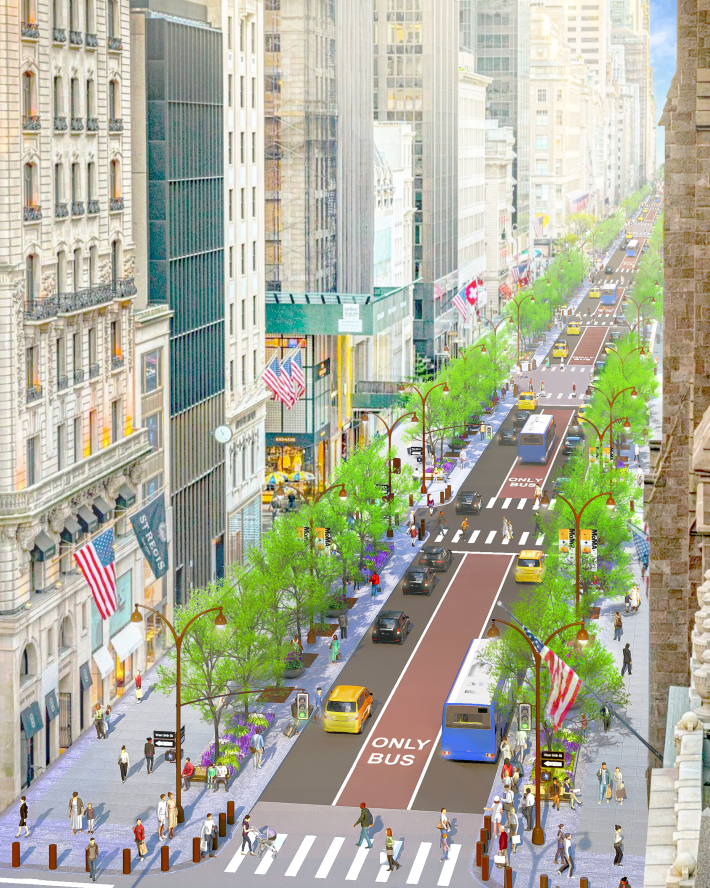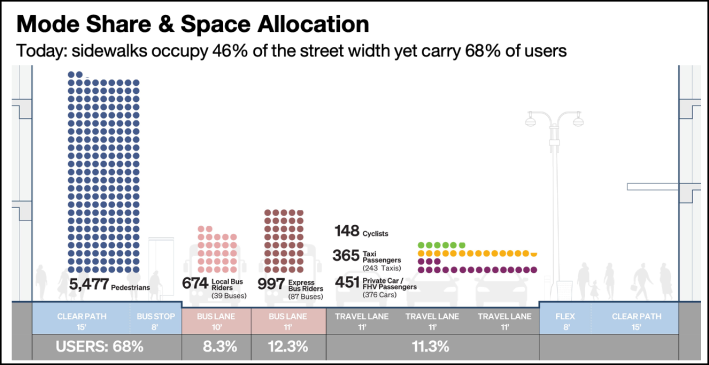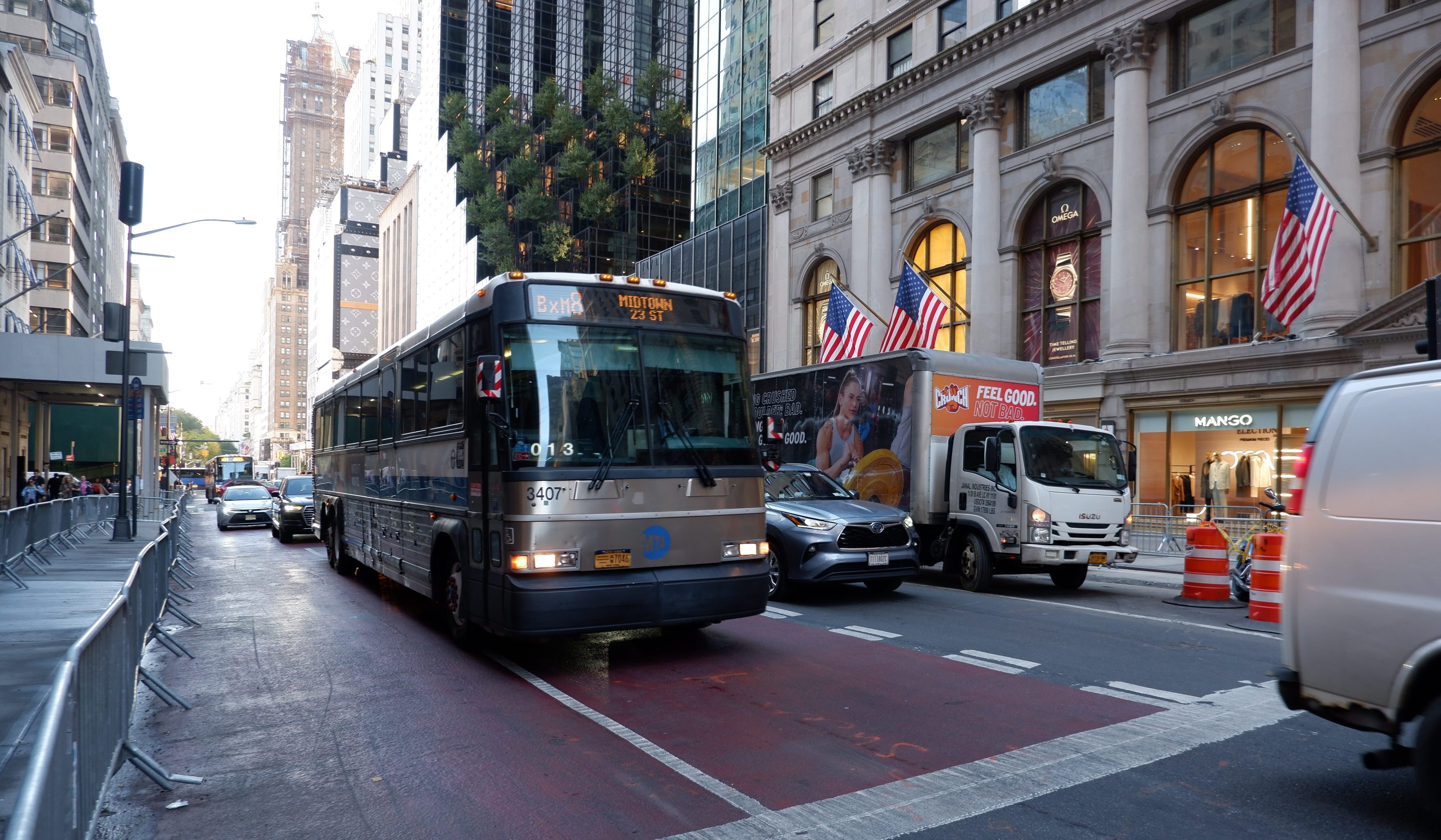The Adams administration's watered down redesign of Fifth Avenue in Midtown is "crazy" and threatens a "slowdown" in transit service on the city's busiest bus corridor, transportation professionals warned.
The mayor and his allies in the powerful high-end business community want to remove one of two existing bus lanes to widen sidewalks on the crowded thoroughfare from Central Park to Bryant Park, but both red-painted paths are essential for carrying more than 100,000 daily straphangers on the avenue, according to experts.
"Without traffic restrictions, ... I would expect a slowdown in bus speeds and an increase in unreliability," one senior local transportation planner told Streetsblog. "We would likely essentially have less service.
"This is a place where the MTA actually has a lot of growth in ridership, approaching capacity on a lot of these express routes, so it’s not like there are spare seats to give away to lost time here," the planner added.
The city and business groups like the Fifth Avenue Association promoted the proposal as giving more space to pedestrians, who comprise 70 percent of traffic on Fifth Avenue. And while those changes are an improvement, it retains the status quo of reserving a majority of road lanes for private vehicles.

The changes also got rid of a protected bike path slated for the corridor under previous plans.
One regular bus rider worried that his coach will get stuck in congestion as it does during the Gridlock Alert days.
"It would make it feel like the U.N. is back in town every week," said Jerry H., who takes the bus from uptown Manhattan to Midtown three times a week.
Busway plans
Fifth Avenue was originally supposed to become a largely car-free busway — similar to the successful 14th Street redesign, with through traffic banned — under a proposal by the de Blasio administration in 2020. But the former mayor watered down the project after real estate bigwigs kicked up a stink in 2021 by bringing back pass-through vehicles, and even that scaled-back project faced years of planning gridlock.
But the Midtown boulevard needs the busway love even more than its downtown counterpart, the local planner Streetsblog spoke to said, given its heavy traffic of 40 bus routes carrying 110,000 passengers each day.
"It’s not 14th Street, and I mean if anything, it’s busier," the planner said. "There’s more bus traffic there, it’s more intense for transit ridership.
"So it actually, I think, would be even more beneficial."
Under the new $350-million plan that the city devised together with business groups over the last nearly two years, the sidewalk would widen by 46 percent, by cutting the roadway down from five lanes to three, with construction not starting until 2028.
Buses would get just one dedicated lane running down the center, however, while the two curbside lanes appear to remain regular car lanes, based on renderings City Hall released Thursday.

The western curb lane could become a "shared lane" the Times reported, but it's unclear how that would differ from a car lane, and officials have refused to give specifics.
City and state transportation professionals have worked on speeding up buses along Fifth Avenue since at least the Bloomberg administration, because the downtown-bound strip along with its uptown-bound counterpart on Madison Avenue are the busiest for bus traffic citywide, according to the Metropolitan Transportation Authority.
Half the people taking the bus to Fifth Avenue stay within one avenue when they get there, and as many as 80 percent don't venture further than two avenues, according to the MTA.
The corridors carry local and express buses, which need to be able to pass each other at stops, which is especially important for the latter group, since they don't drop off and pick up passengers as frequently, according to bus experts.
"The express buses shouldn’t have to get stuck behind a local bus at a bus stop, because then there’s no point in having the express bus," said Annie Weinstock, the director of Programs at the group People-Oriented Cities, which researches and advocates for moving cities away from car-centric design.
Leaving just one lane for buses, while mixing transit with general traffic along the curb.
"It seems a little crazy to me," Weinstock said. "The local buses would be pulling in and out of the lane, and they would have to merge with traffic every time. That’s a step down from what we have now, which is a double bus lane.
“You end up with a lot of criss-crossing and delay," she added.
Buses would get delayed behind other buses at stops as well, or behind the many drivers still using Fifth Avenue, even if it has fewer overall lanes, the transit researcher said.
"You would end up with a lot of bus queuing, which certainly the MTA could keep the service, but it would be very poor," Weinstock said. "Their service would degrade."
A decade-and-a-half of plans
Weinstock helped craft bus lane designs for the city on Madison and Fifth Avenues in 2008, while working at the engineering firm Sam Schwartz back then. Madison Avenue already had its dual bus lane in the afternoons dating back to the Koch administration, but the city implemented full-time regulations there in 2012 and doubled the lanes on Fifth Avenue to match the design in 2017.
In its public presentation for Fifth seven years ago, DOT noted that less than one-eighth of people drove their private vehicles on the corridor during the morning rush, while 40 percent rode the bus.
Up to 130 buses passed through the corridor an hour, according to the agency stats. Even combining private cars with taxis and for-hire vehicles, bus riders still well outnumbered those road users.

More recent stats by the Fifth Avenue Association show buses make up nearly two-thirds of people traveling in the roadbed, though three out of the five current lanes are still for cars.
Reps for that local group claimed the new design was "data-driven," but the data show that bus riders are still getting disproportionately less road than motorists.
An earlier rendering Adams touted when he announced the partnership with business groups had just one car lane and included a bike lane, which is now gone, despite the nearly 150 cyclists riding through every hour, according to the Association's stats.

The city is going in the wrong direction by pitting pedestrians, cyclists, and transit riders against each other in favor of private autos, said Bruce Schaller, a former deputy commissioner at DOT under the Bloomberg administration who worked on the double-lane design.
"Seems to me deeply disappointing that here in 2024 pedestrians, buses and bikes are being put in opposition to each other while auto traffic — the least efficient and least urban of all transport modes aside from helicoptering to the airport — is given free rein," Schaller wrote in an email.
City Hall's press release claimed its grand new design iteration was inspired by other global shopping meccas, like London's Oxford Street, but Schaller said the Big Apple should take closer notes from British city, which has for years limited that road to buses, taxis, and bikes in the daytime six days a week.
During Monday's morning rush, dozens of buses rolled down Fifth Avenue around police barricades near Trump Tower and a hodgepodge of yellow cabs, private cars, cyclists, and micromobility riders.
Riders were unimpressed by the city's plans, telling Streetsblog that they feared having to spend more time on their commute as a result.
"You’re just gonna have to leave earlier, because it’s gonna slow everybody down," said Eva H., who has been taking the express bus from the Bronx for a decade.
One midtown resident echoed concerns about giving buses enough space to pull in and out, saying drivers already intruded on the red painted lanes too often.
"That’ll be a problem," said Jenny Zhen. "A lot of the time, regular cars just go into it."
A spokesperson for the Fifth Avenue Association argued that the new proposal was a "win for all New Yorkers" by giving more space to pedestrians, while claiming it would reduce congestion.
"Congestion from cars using the street purely as a means for getting downtown or driving to other parts of the city will ease – significantly reducing gridlock on the road, including for buses," Claire Holmes said in a statement. "This thoughtful data-driven plan represents a win for all New Yorkers who use Fifth Avenue. It will change it from a major congested roadway into a pedestrian-focused corridor."
A City Hall spokesperson said the city will work with the MTA to "analyze traffic impacts."
"As we advance the design of this plan, we are confident we will balance the needs of every road user — whether they are on foot, using public transit, or otherwise," said Liz Garcia in a statement.






